Health Economics
VerifiedAdded on 2023/06/11
|7
|1448
|413
AI Summary
This article discusses proposed solutions for interoperability, standards and HER architecture in health economics. It also recommends the implementation of EHR to hospital management teams for improved healthcare administration processes and patient protection.
Contribute Materials
Your contribution can guide someone’s learning journey. Share your
documents today.
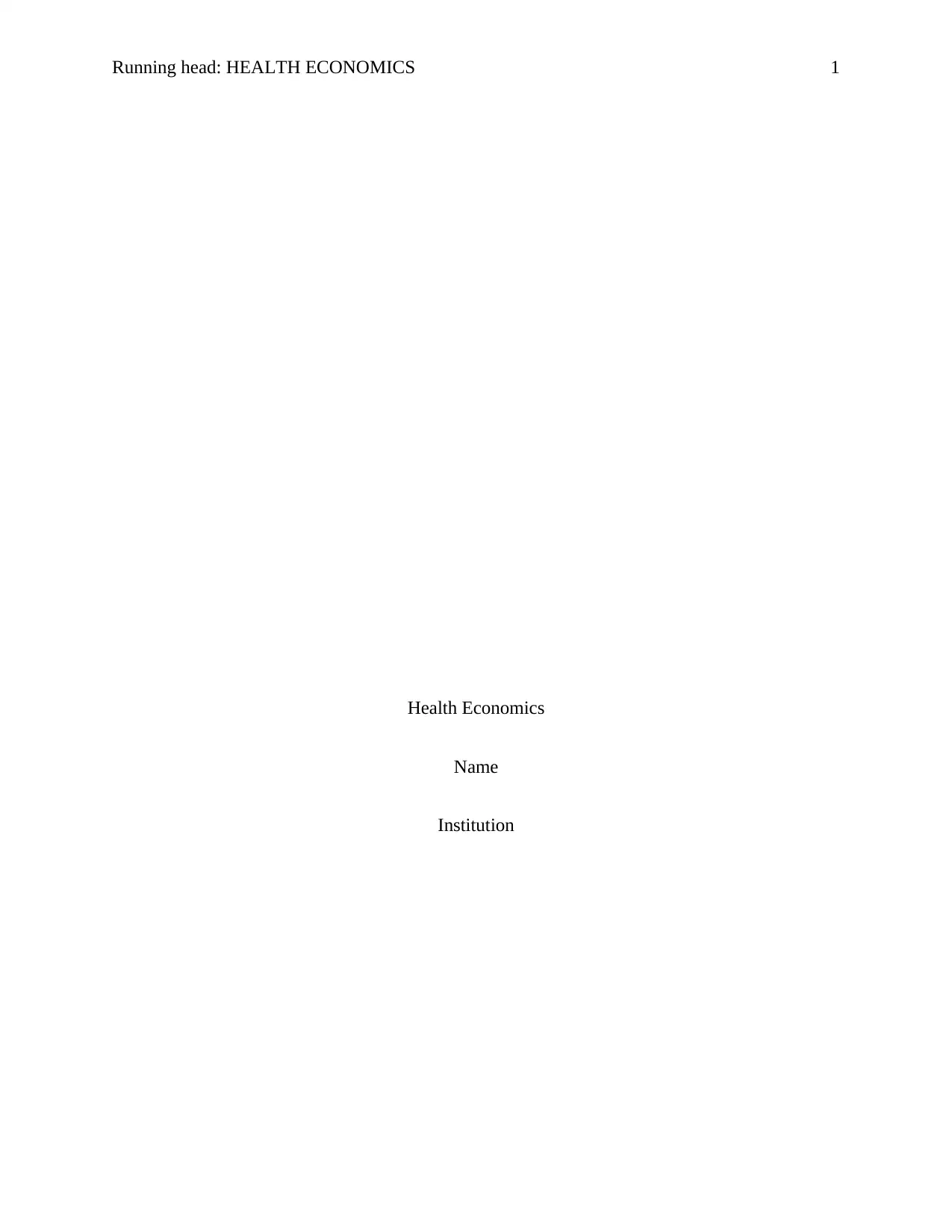
Running head: HEALTH ECONOMICS 1
Health Economics
Name
Institution
Health Economics
Name
Institution
Secure Best Marks with AI Grader
Need help grading? Try our AI Grader for instant feedback on your assignments.
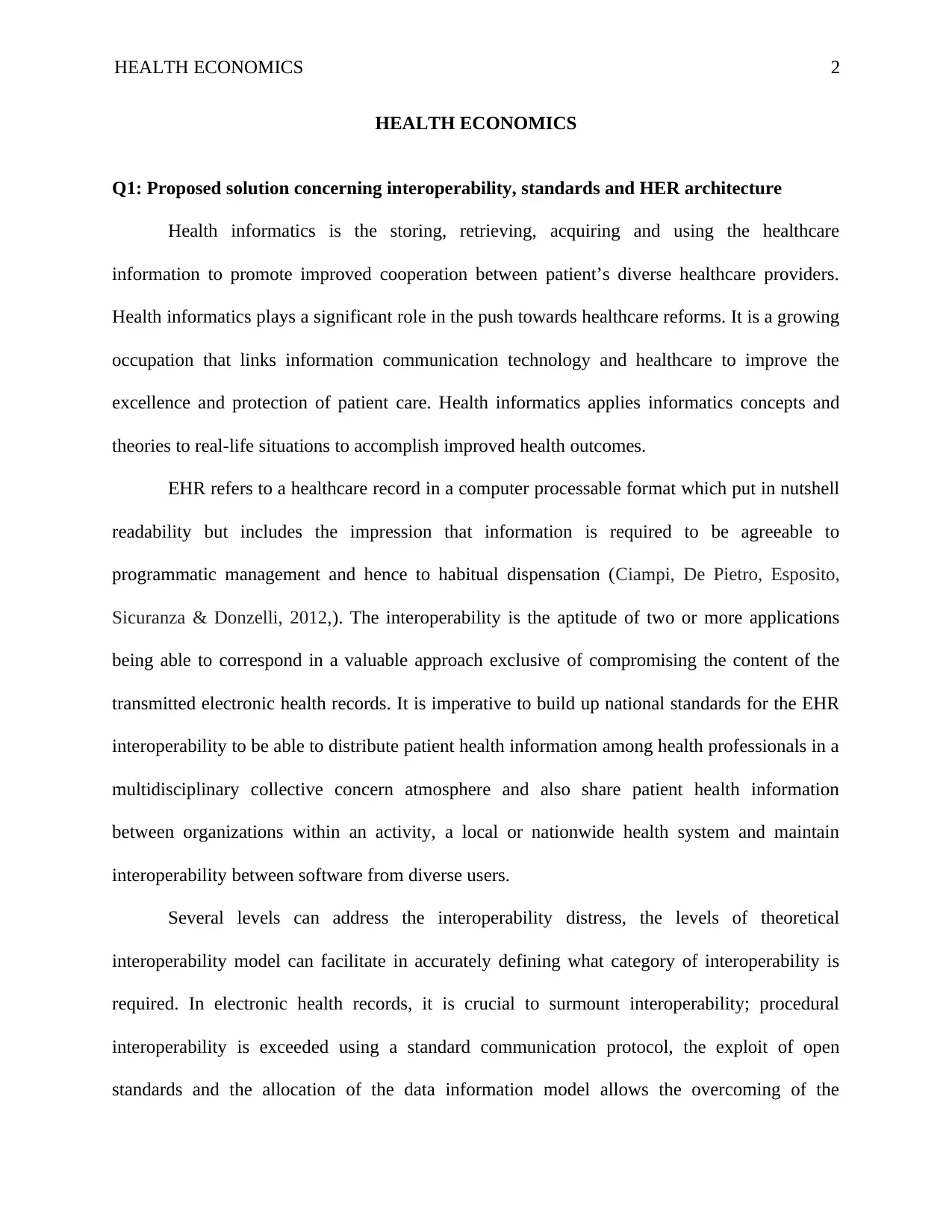
HEALTH ECONOMICS 2
HEALTH ECONOMICS
Q1: Proposed solution concerning interoperability, standards and HER architecture
Health informatics is the storing, retrieving, acquiring and using the healthcare
information to promote improved cooperation between patient’s diverse healthcare providers.
Health informatics plays a significant role in the push towards healthcare reforms. It is a growing
occupation that links information communication technology and healthcare to improve the
excellence and protection of patient care. Health informatics applies informatics concepts and
theories to real-life situations to accomplish improved health outcomes.
EHR refers to a healthcare record in a computer processable format which put in nutshell
readability but includes the impression that information is required to be agreeable to
programmatic management and hence to habitual dispensation (Ciampi, De Pietro, Esposito,
Sicuranza & Donzelli, 2012,). The interoperability is the aptitude of two or more applications
being able to correspond in a valuable approach exclusive of compromising the content of the
transmitted electronic health records. It is imperative to build up national standards for the EHR
interoperability to be able to distribute patient health information among health professionals in a
multidisciplinary collective concern atmosphere and also share patient health information
between organizations within an activity, a local or nationwide health system and maintain
interoperability between software from diverse users.
Several levels can address the interoperability distress, the levels of theoretical
interoperability model can facilitate in accurately defining what category of interoperability is
required. In electronic health records, it is crucial to surmount interoperability; procedural
interoperability is exceeded using a standard communication protocol, the exploit of open
standards and the allocation of the data information model allows the overcoming of the
HEALTH ECONOMICS
Q1: Proposed solution concerning interoperability, standards and HER architecture
Health informatics is the storing, retrieving, acquiring and using the healthcare
information to promote improved cooperation between patient’s diverse healthcare providers.
Health informatics plays a significant role in the push towards healthcare reforms. It is a growing
occupation that links information communication technology and healthcare to improve the
excellence and protection of patient care. Health informatics applies informatics concepts and
theories to real-life situations to accomplish improved health outcomes.
EHR refers to a healthcare record in a computer processable format which put in nutshell
readability but includes the impression that information is required to be agreeable to
programmatic management and hence to habitual dispensation (Ciampi, De Pietro, Esposito,
Sicuranza & Donzelli, 2012,). The interoperability is the aptitude of two or more applications
being able to correspond in a valuable approach exclusive of compromising the content of the
transmitted electronic health records. It is imperative to build up national standards for the EHR
interoperability to be able to distribute patient health information among health professionals in a
multidisciplinary collective concern atmosphere and also share patient health information
between organizations within an activity, a local or nationwide health system and maintain
interoperability between software from diverse users.
Several levels can address the interoperability distress, the levels of theoretical
interoperability model can facilitate in accurately defining what category of interoperability is
required. In electronic health records, it is crucial to surmount interoperability; procedural
interoperability is exceeded using a standard communication protocol, the exploit of open
standards and the allocation of the data information model allows the overcoming of the
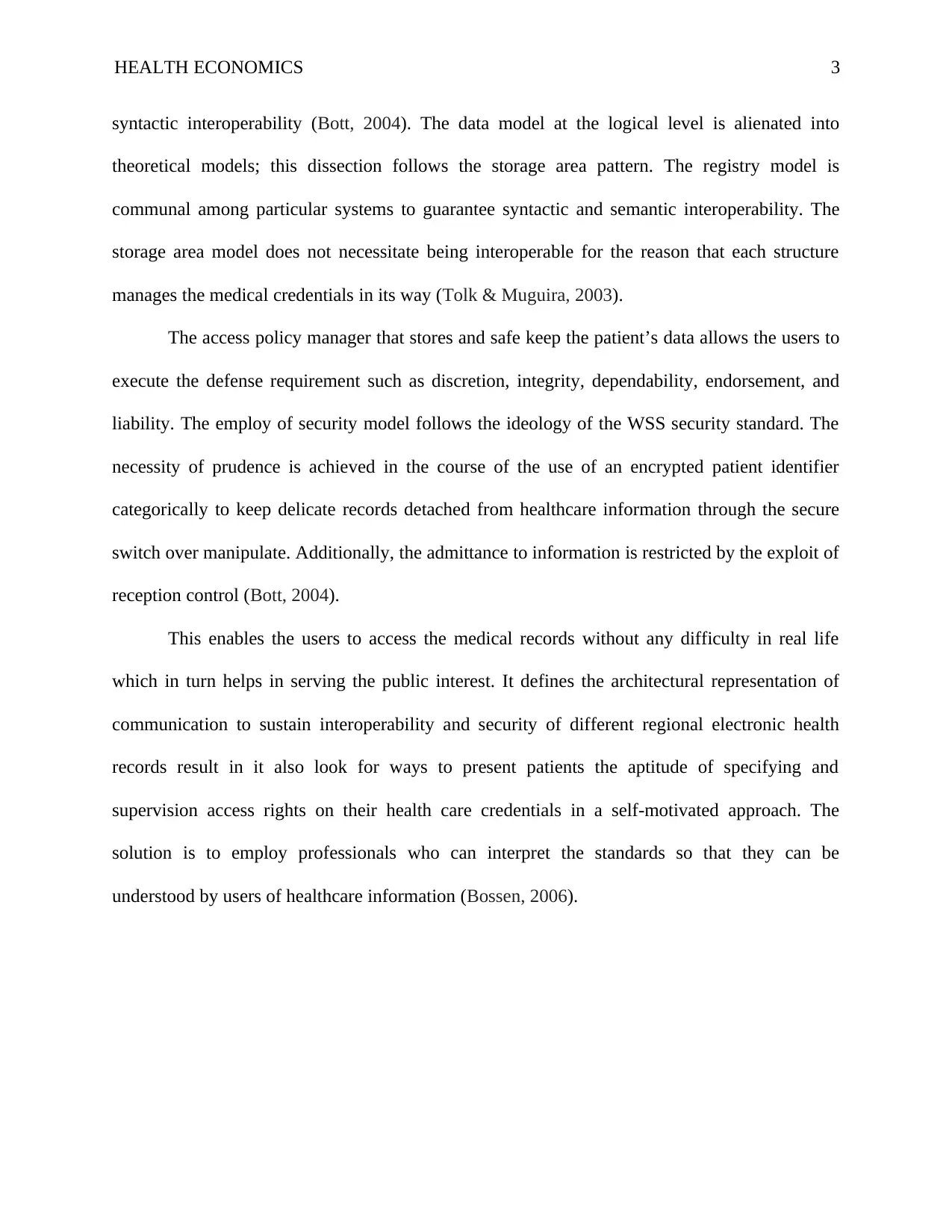
HEALTH ECONOMICS 3
syntactic interoperability (Bott, 2004). The data model at the logical level is alienated into
theoretical models; this dissection follows the storage area pattern. The registry model is
communal among particular systems to guarantee syntactic and semantic interoperability. The
storage area model does not necessitate being interoperable for the reason that each structure
manages the medical credentials in its way (Tolk & Muguira, 2003).
The access policy manager that stores and safe keep the patient’s data allows the users to
execute the defense requirement such as discretion, integrity, dependability, endorsement, and
liability. The employ of security model follows the ideology of the WSS security standard. The
necessity of prudence is achieved in the course of the use of an encrypted patient identifier
categorically to keep delicate records detached from healthcare information through the secure
switch over manipulate. Additionally, the admittance to information is restricted by the exploit of
reception control (Bott, 2004).
This enables the users to access the medical records without any difficulty in real life
which in turn helps in serving the public interest. It defines the architectural representation of
communication to sustain interoperability and security of different regional electronic health
records result in it also look for ways to present patients the aptitude of specifying and
supervision access rights on their health care credentials in a self-motivated approach. The
solution is to employ professionals who can interpret the standards so that they can be
understood by users of healthcare information (Bossen, 2006).
syntactic interoperability (Bott, 2004). The data model at the logical level is alienated into
theoretical models; this dissection follows the storage area pattern. The registry model is
communal among particular systems to guarantee syntactic and semantic interoperability. The
storage area model does not necessitate being interoperable for the reason that each structure
manages the medical credentials in its way (Tolk & Muguira, 2003).
The access policy manager that stores and safe keep the patient’s data allows the users to
execute the defense requirement such as discretion, integrity, dependability, endorsement, and
liability. The employ of security model follows the ideology of the WSS security standard. The
necessity of prudence is achieved in the course of the use of an encrypted patient identifier
categorically to keep delicate records detached from healthcare information through the secure
switch over manipulate. Additionally, the admittance to information is restricted by the exploit of
reception control (Bott, 2004).
This enables the users to access the medical records without any difficulty in real life
which in turn helps in serving the public interest. It defines the architectural representation of
communication to sustain interoperability and security of different regional electronic health
records result in it also look for ways to present patients the aptitude of specifying and
supervision access rights on their health care credentials in a self-motivated approach. The
solution is to employ professionals who can interpret the standards so that they can be
understood by users of healthcare information (Bossen, 2006).
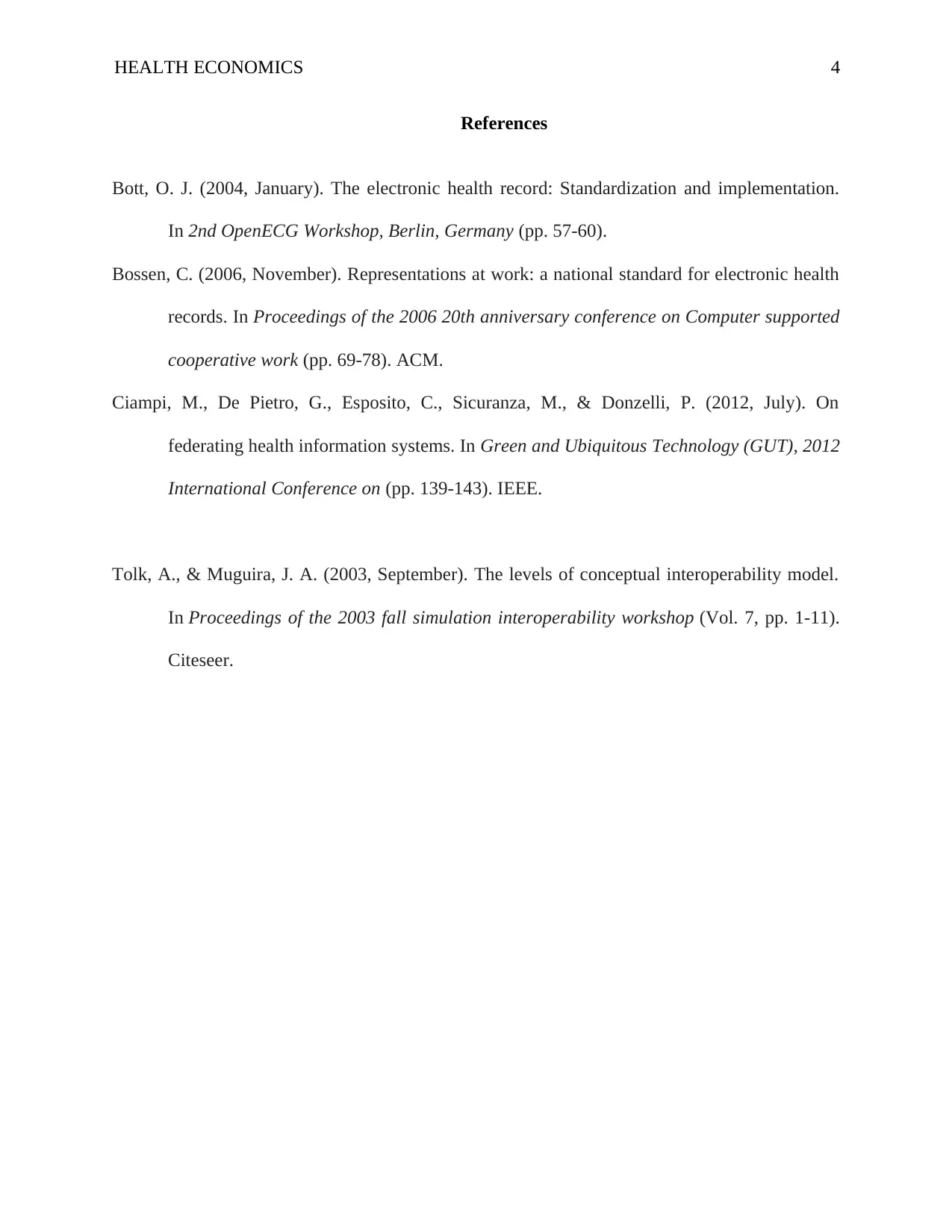
HEALTH ECONOMICS 4
References
Bott, O. J. (2004, January). The electronic health record: Standardization and implementation.
In 2nd OpenECG Workshop, Berlin, Germany (pp. 57-60).
Bossen, C. (2006, November). Representations at work: a national standard for electronic health
records. In Proceedings of the 2006 20th anniversary conference on Computer supported
cooperative work (pp. 69-78). ACM.
Ciampi, M., De Pietro, G., Esposito, C., Sicuranza, M., & Donzelli, P. (2012, July). On
federating health information systems. In Green and Ubiquitous Technology (GUT), 2012
International Conference on (pp. 139-143). IEEE.
Tolk, A., & Muguira, J. A. (2003, September). The levels of conceptual interoperability model.
In Proceedings of the 2003 fall simulation interoperability workshop (Vol. 7, pp. 1-11).
Citeseer.
References
Bott, O. J. (2004, January). The electronic health record: Standardization and implementation.
In 2nd OpenECG Workshop, Berlin, Germany (pp. 57-60).
Bossen, C. (2006, November). Representations at work: a national standard for electronic health
records. In Proceedings of the 2006 20th anniversary conference on Computer supported
cooperative work (pp. 69-78). ACM.
Ciampi, M., De Pietro, G., Esposito, C., Sicuranza, M., & Donzelli, P. (2012, July). On
federating health information systems. In Green and Ubiquitous Technology (GUT), 2012
International Conference on (pp. 139-143). IEEE.
Tolk, A., & Muguira, J. A. (2003, September). The levels of conceptual interoperability model.
In Proceedings of the 2003 fall simulation interoperability workshop (Vol. 7, pp. 1-11).
Citeseer.
Secure Best Marks with AI Grader
Need help grading? Try our AI Grader for instant feedback on your assignments.
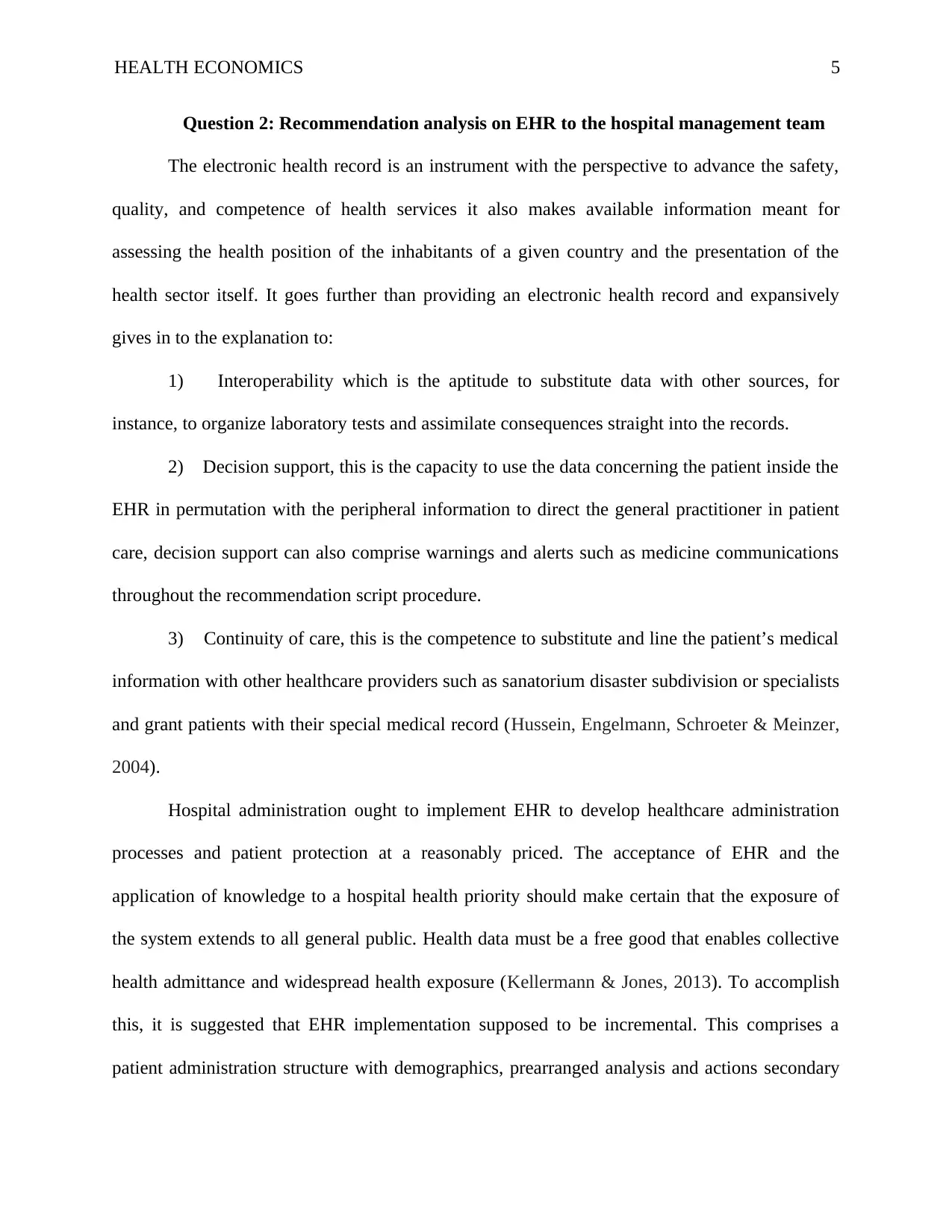
HEALTH ECONOMICS 5
Question 2: Recommendation analysis on EHR to the hospital management team
The electronic health record is an instrument with the perspective to advance the safety,
quality, and competence of health services it also makes available information meant for
assessing the health position of the inhabitants of a given country and the presentation of the
health sector itself. It goes further than providing an electronic health record and expansively
gives in to the explanation to:
1) Interoperability which is the aptitude to substitute data with other sources, for
instance, to organize laboratory tests and assimilate consequences straight into the records.
2) Decision support, this is the capacity to use the data concerning the patient inside the
EHR in permutation with the peripheral information to direct the general practitioner in patient
care, decision support can also comprise warnings and alerts such as medicine communications
throughout the recommendation script procedure.
3) Continuity of care, this is the competence to substitute and line the patient’s medical
information with other healthcare providers such as sanatorium disaster subdivision or specialists
and grant patients with their special medical record (Hussein, Engelmann, Schroeter & Meinzer,
2004).
Hospital administration ought to implement EHR to develop healthcare administration
processes and patient protection at a reasonably priced. The acceptance of EHR and the
application of knowledge to a hospital health priority should make certain that the exposure of
the system extends to all general public. Health data must be a free good that enables collective
health admittance and widespread health exposure (Kellermann & Jones, 2013). To accomplish
this, it is suggested that EHR implementation supposed to be incremental. This comprises a
patient administration structure with demographics, prearranged analysis and actions secondary
Question 2: Recommendation analysis on EHR to the hospital management team
The electronic health record is an instrument with the perspective to advance the safety,
quality, and competence of health services it also makes available information meant for
assessing the health position of the inhabitants of a given country and the presentation of the
health sector itself. It goes further than providing an electronic health record and expansively
gives in to the explanation to:
1) Interoperability which is the aptitude to substitute data with other sources, for
instance, to organize laboratory tests and assimilate consequences straight into the records.
2) Decision support, this is the capacity to use the data concerning the patient inside the
EHR in permutation with the peripheral information to direct the general practitioner in patient
care, decision support can also comprise warnings and alerts such as medicine communications
throughout the recommendation script procedure.
3) Continuity of care, this is the competence to substitute and line the patient’s medical
information with other healthcare providers such as sanatorium disaster subdivision or specialists
and grant patients with their special medical record (Hussein, Engelmann, Schroeter & Meinzer,
2004).
Hospital administration ought to implement EHR to develop healthcare administration
processes and patient protection at a reasonably priced. The acceptance of EHR and the
application of knowledge to a hospital health priority should make certain that the exposure of
the system extends to all general public. Health data must be a free good that enables collective
health admittance and widespread health exposure (Kellermann & Jones, 2013). To accomplish
this, it is suggested that EHR implementation supposed to be incremental. This comprises a
patient administration structure with demographics, prearranged analysis and actions secondary
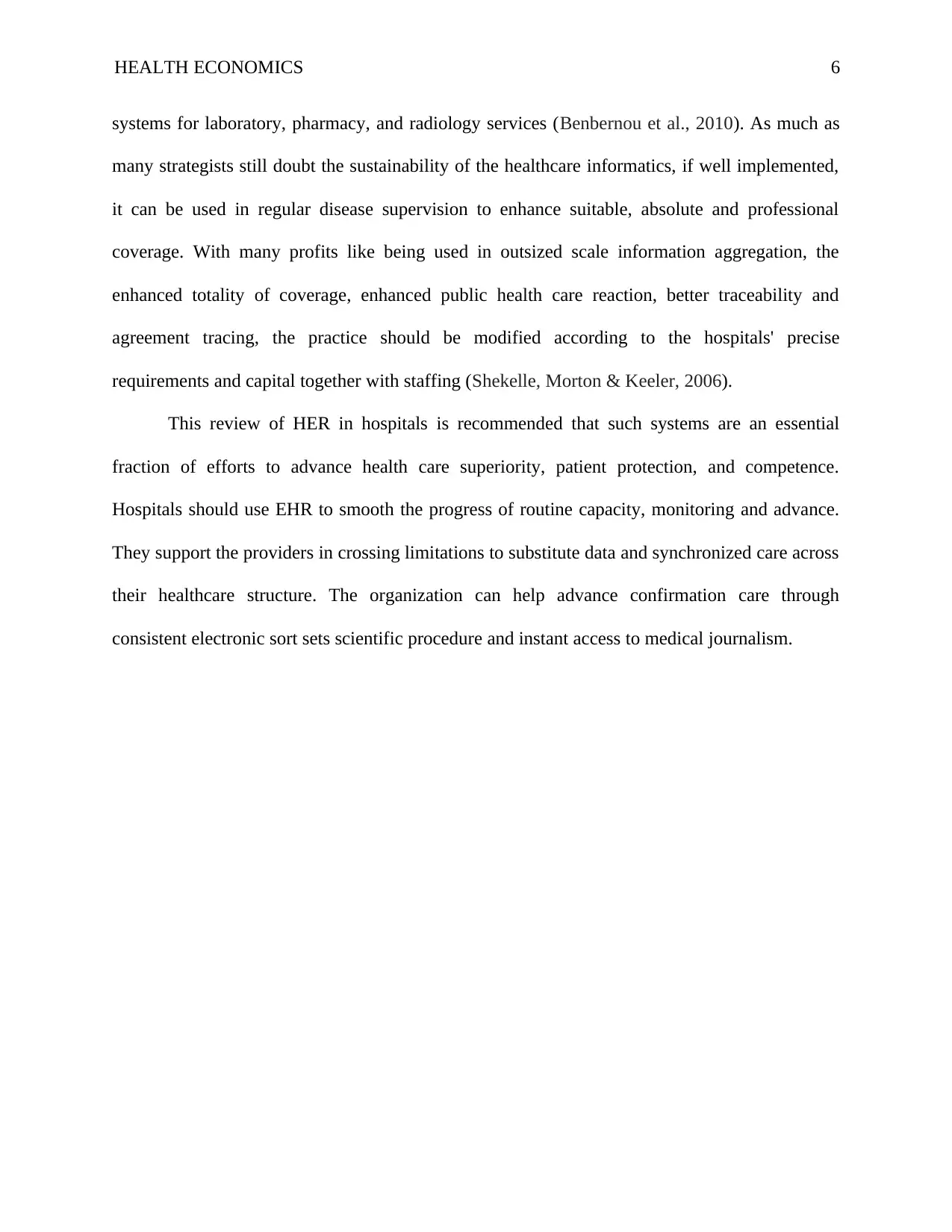
HEALTH ECONOMICS 6
systems for laboratory, pharmacy, and radiology services (Benbernou et al., 2010). As much as
many strategists still doubt the sustainability of the healthcare informatics, if well implemented,
it can be used in regular disease supervision to enhance suitable, absolute and professional
coverage. With many profits like being used in outsized scale information aggregation, the
enhanced totality of coverage, enhanced public health care reaction, better traceability and
agreement tracing, the practice should be modified according to the hospitals' precise
requirements and capital together with staffing (Shekelle, Morton & Keeler, 2006).
This review of HER in hospitals is recommended that such systems are an essential
fraction of efforts to advance health care superiority, patient protection, and competence.
Hospitals should use EHR to smooth the progress of routine capacity, monitoring and advance.
They support the providers in crossing limitations to substitute data and synchronized care across
their healthcare structure. The organization can help advance confirmation care through
consistent electronic sort sets scientific procedure and instant access to medical journalism.
systems for laboratory, pharmacy, and radiology services (Benbernou et al., 2010). As much as
many strategists still doubt the sustainability of the healthcare informatics, if well implemented,
it can be used in regular disease supervision to enhance suitable, absolute and professional
coverage. With many profits like being used in outsized scale information aggregation, the
enhanced totality of coverage, enhanced public health care reaction, better traceability and
agreement tracing, the practice should be modified according to the hospitals' precise
requirements and capital together with staffing (Shekelle, Morton & Keeler, 2006).
This review of HER in hospitals is recommended that such systems are an essential
fraction of efforts to advance health care superiority, patient protection, and competence.
Hospitals should use EHR to smooth the progress of routine capacity, monitoring and advance.
They support the providers in crossing limitations to substitute data and synchronized care across
their healthcare structure. The organization can help advance confirmation care through
consistent electronic sort sets scientific procedure and instant access to medical journalism.
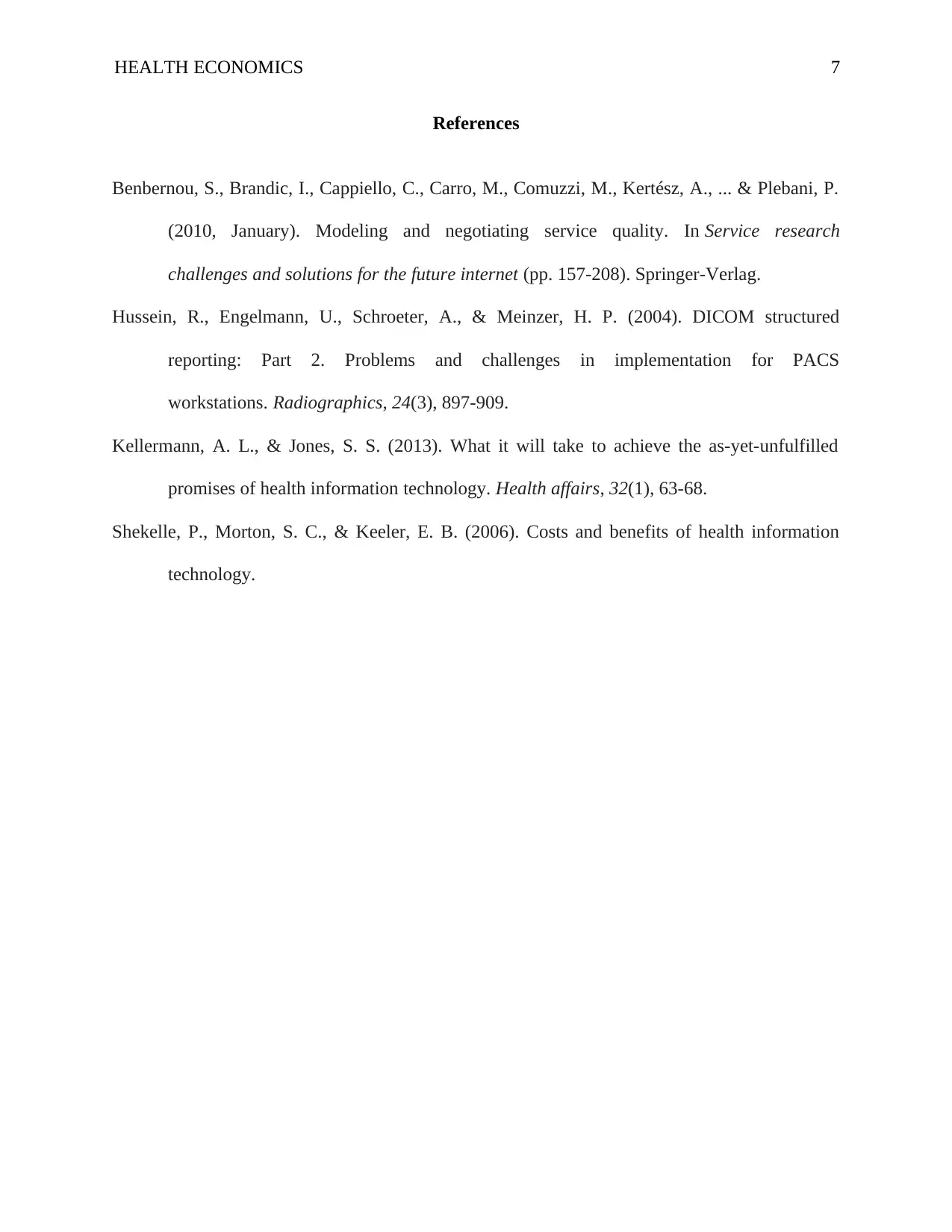
HEALTH ECONOMICS 7
References
Benbernou, S., Brandic, I., Cappiello, C., Carro, M., Comuzzi, M., Kertész, A., ... & Plebani, P.
(2010, January). Modeling and negotiating service quality. In Service research
challenges and solutions for the future internet (pp. 157-208). Springer-Verlag.
Hussein, R., Engelmann, U., Schroeter, A., & Meinzer, H. P. (2004). DICOM structured
reporting: Part 2. Problems and challenges in implementation for PACS
workstations. Radiographics, 24(3), 897-909.
Kellermann, A. L., & Jones, S. S. (2013). What it will take to achieve the as-yet-unfulfilled
promises of health information technology. Health affairs, 32(1), 63-68.
Shekelle, P., Morton, S. C., & Keeler, E. B. (2006). Costs and benefits of health information
technology.
References
Benbernou, S., Brandic, I., Cappiello, C., Carro, M., Comuzzi, M., Kertész, A., ... & Plebani, P.
(2010, January). Modeling and negotiating service quality. In Service research
challenges and solutions for the future internet (pp. 157-208). Springer-Verlag.
Hussein, R., Engelmann, U., Schroeter, A., & Meinzer, H. P. (2004). DICOM structured
reporting: Part 2. Problems and challenges in implementation for PACS
workstations. Radiographics, 24(3), 897-909.
Kellermann, A. L., & Jones, S. S. (2013). What it will take to achieve the as-yet-unfulfilled
promises of health information technology. Health affairs, 32(1), 63-68.
Shekelle, P., Morton, S. C., & Keeler, E. B. (2006). Costs and benefits of health information
technology.
1 out of 7
Related Documents
Your All-in-One AI-Powered Toolkit for Academic Success.
+13062052269
info@desklib.com
Available 24*7 on WhatsApp / Email
![[object Object]](/_next/static/media/star-bottom.7253800d.svg)
Unlock your academic potential
© 2024 | Zucol Services PVT LTD | All rights reserved.





